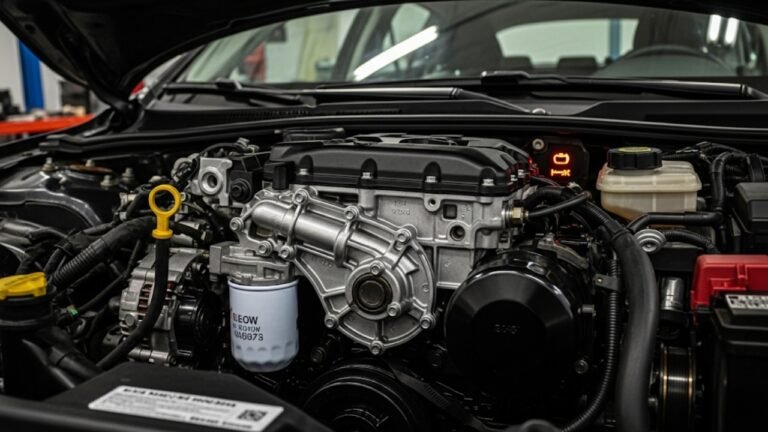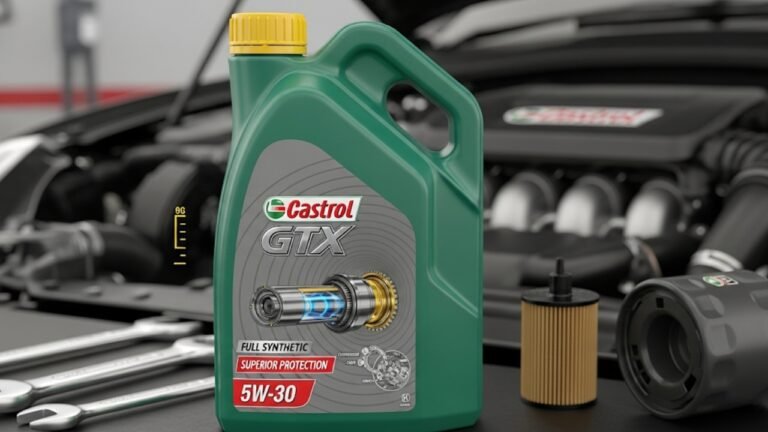What Happens If Car Is Overfilled With Oil?

Imagine this: It’s a sunny Sunday. You pop your car’s hood, oil in hand, feeling proud and responsible. You add oil because your dashboard flashed a warning earlier in the week. You pour… then pour a little more… just to be sure.
But here’s the twist—what happens if car is overfilled with oil?
Many of us have been there. It seems harmless. After all, oil is good, right? It cools the engine, keeps things smooth, and reduces wear and tear. But just like overwatering a plant can drown its roots, overfilling oil in a car can flood your engine, causing damage, smoke, leaks, or worse.
Let’s take a deep breath and explore what really goes down when your oil line crosses the limit—and how you can avoid turning a simple top-off into a full-blown mechanic visit.
What Is Considered “Too Much Oil” in a Car?
You might think, “Well, I didn’t pour a whole gallon extra—just a little above the line.”
But here’s the thing: engines are precision machines. Even an extra half quart of oil can push the limit.
Modern cars have tight tolerances. The oil pan, where oil settles, has a maximum level for a reason. It’s measured using the dipstick, and going above the full mark isn’t just a number issue—it changes how the entire engine behaves.
A Rule of Thumb:
- Ideal oil level: Between the “Low” and “Full” marks on the dipstick.
- Too much oil: 1/2 quart or more above the full line.
- Danger zone: 1+ quart extra can lead to immediate issues.
Overfilling oil might not explode your engine immediately. But trust me—it starts a chain reaction. Let’s see how.
Symptom 1: White Smoke and Burning Smell
One of the first signs your car has had too much oil is a cloud of white smoke trailing behind you. Think of it like the engine’s way of crying out, “Help!”
What’s Happening?
Excess oil gets into places it shouldn’t—like the combustion chamber. Once in there, it burns off, releasing thick smoke that smells… well, awful. It’s a bit like leaving butter on a hot pan until it turns brown and nasty.
You might also notice:
- Burning oil smell inside the cabin
- Poor visibility behind you due to smoke
- Embarrassed looks from drivers behind
If you see this, pull over and check your oil level right away. Don’t let it escalate.
Symptom 2: Engine Misfire or Rough Idling
Let’s get technical—but don’t worry, I’ll keep it simple.
Engines rely on the air-fuel mixture. Too much oil can throw off this balance. Here’s a metaphor: imagine trying to breathe with a pillow over your mouth. That’s what it feels like to your engine when oil seeps into the intake system.
Real-World Effects:
- Engine jerks when idle
- Feels sluggish when accelerating
- Check Engine Light might come on
Over time, this “choking effect” can ruin spark plugs, clog the air filter, and mess with the fuel injectors. You’ll feel it in your wallet if it goes unchecked.
Symptom 3: Blown Gaskets and Oil Leaks
Oil is meant to lubricate, not to leak. But when there’s too much of it, pressure builds in the crankcase. And here’s the scary part: that pressure looks for a way out.
Often, it bursts through gaskets and seals. These are like the tight rubber bands holding the engine together. When they break, your engine starts to leak oil—and not just a few drops.
What You Might Notice:
- Oil puddles under your parked car
- Sticky, wet gunk near engine seals
- Slippery driveways (not fun to clean)
Replacing a blown head gasket can cost hundreds, even thousands of dollars. And all of it from a little too much oil. It’s like adding too much pressure to a balloon—it will pop.
Symptom 4: Frothy Oil – When Lubrication Fails
This one’s sneaky but dangerous. When the crankshaft spins in too much oil, it acts like a mixer. The oil starts to foam and froth—like a latte machine gone wild.
And what’s wrong with frothy oil? Well, it loses its lubricating power.
Your engine parts start grinding instead of gliding.
The Outcome?
- Increased engine wear
- Strange knocking sounds
- Sudden overheating
Think of your engine like joints in your body. Without enough lubrication, everything becomes stiff, painful, and prone to damage. Frothy oil is like drying out the cartilage in your knees.
Internal Damage: Catastrophic Consequences If Ignored
Let’s say you ignore all the signs. You keep driving. What happens next?
The frothy oil fails to do its job. Bearings grind. Pistons heat up. Parts swell from friction. Eventually, something gives out—maybe a connecting rod, maybe your timing chain.
You might even suffer a complete engine failure.
And let’s be real—that’s not just a car problem. That’s a financial crisis. A blown engine can cost anywhere from $2,000 to $7,000 to replace.
All from pouring “just a little extra.”
Quick Comparison Table: Normal vs Overfilled Oil
| Feature | Normal Oil Level | Overfilled Oil Condition |
|---|---|---|
| Engine Performance | Smooth, efficient | Sluggish, rough, misfiring |
| Oil Appearance | Clear and smooth | Foamy, bubbly |
| Emission Output | Normal exhaust | White smoke from tailpipe |
| Cabin Smell | Neutral | Burning oil smell |
| Risk of Engine Damage | Very low | High to severe |
| Cost of Repair | Routine maintenance | Hundreds to thousands of dollars |
This table puts it all into perspective. Sometimes the numbers say more than words.
What To Do If You’ve Overfilled Oil
So, maybe you’re panicking right now. That’s okay.
The good news? If you catch it early, you can fix it yourself or with a little help.
Here’s what you can do:
Steps to Fix It:
- Check the oil level using the dipstick.
- If it’s above the “Full” line, don’t drive the car.
- Use a syringe pump or fluid extractor to remove excess oil.
- Or visit a mechanic and ask for an oil drain and refill.
Don’t wait too long. Oil doesn’t just sit still—it circulates. The longer you wait, the more chance it reaches where it shouldn’t.
How to Prevent Overfilling Your Car’s Oil
Here’s the truth: overfilling oil is 100% preventable. All it takes is a little patience and attention to detail.
If you’ve ever baked a cake, you know how important measurements are. Too much flour? Dry cake. Too much sugar? Overly sweet. Your car’s engine is no different—it needs just the right amount.
Tips to Avoid Overfilling:
- Read your owner’s manual: It tells you the exact oil capacity in quarts or liters. Stick to that.
- Use a measuring funnel: Pour slowly and in small amounts. Check frequently.
- Wait before checking: After adding oil, give it 5-10 minutes to settle before rechecking the dipstick.
- Change oil in daylight: Good lighting helps avoid over-pouring.
- Double-check: If you’re unsure, it’s safer to be slightly under than over.
Overconfidence is the #1 reason people make this mistake. Slow down, trust the process, and your engine will thank you.
How to Check Oil the Right Way – Step-by-Step
Let’s go back to basics. Knowing how to check your oil level properly could save you from a world of pain (and money).
Here’s a simple 7-step process:
- Park on a level surface
- Avoid slanted driveways or hills. Uneven surfaces give false readings.
- Turn off the engine
- Let it cool for 5–10 minutes. Hot oil gives inaccurate levels.
- Pop the hood and find the dipstick
- Usually has a yellow or orange looped handle.
- Wipe it clean with a rag
- The first pull is just for cleanup.
- Insert it back and pull again
- Now check where the oil reaches between the “Low” and “Full” lines.
- Top up slowly if needed
- Add a little at a time. Recheck after each pour.
- Don’t fill past ‘Full’
- Stop right at or slightly below the line. Done!
You’d be surprised how many seasoned drivers mess this up. But not you—not anymore.
Frequently Asked Questions (FAQs)
Here are some real-life questions people ask when they overfill their car with oil. You may be wondering the same things!
1. Can I drive my car if it’s slightly overfilled with oil?
If it’s just a tiny bit over the “Full” line, and you’re not seeing smoke or leaks, you’re probably okay short-term. But it’s safer to remove the excess ASAP. A few dollars now beats costly repairs later.
2. How do I know if my car is overfilled with oil?
Check for:
- Oil level above the full mark on the dipstick
- White or bluish smoke from the exhaust
- Burning oil smell
- Strange engine noises or sluggish performance
3. What happens if car is overfilled with oil and I ignore it?
Short answer: damage builds up silently. Over time, you risk:
- Blown seals
- Damaged spark plugs
- Overheating
- Total engine failure
What starts small could lead to a full engine replacement. That’s thousands of dollars.
4. Is overfilling oil worse than having low oil?
Both are bad—but in different ways. Low oil causes immediate wear and tear. Overfilled oil damages the engine indirectly, but can be just as serious if ignored.
Aim to stay between the “Low” and “Full” mark always.
5. How do I fix overfilled oil without tools?
If you’re at home and don’t have a pump, your best bet is:
- Carefully unscrew the oil drain bolt just enough to let a bit drip out.
- Re-tighten, wait a few minutes, and recheck the dipstick.
It’s messy, but it works. Wear gloves and use a drain pan!
Final Thoughts: It’s All About Balance
Cars are like relationships—they thrive when treated with care and respect.
Adding oil isn’t just about maintenance. It’s about understanding your vehicle’s needs, rhythms, and limits. Overdoing it—like texting someone 10 times in a row—can do more harm than good.
I’ve seen friends panic after overfilling oil. Some spent $800 on unnecessary repairs. Others got lucky and caught it in time. I once overfilled mine after a long night, thinking I was “playing it safe.” The next day? Smoke, sputtering, and shame.
So here’s my message to you:
- Be gentle with your car.
- Measure twice, pour once.
- Listen when it speaks—through smoke, smells, or strange sounds.
Because what happens if car is overfilled with oil isn’t just mechanical—it’s a lesson in patience, balance, and awareness.






